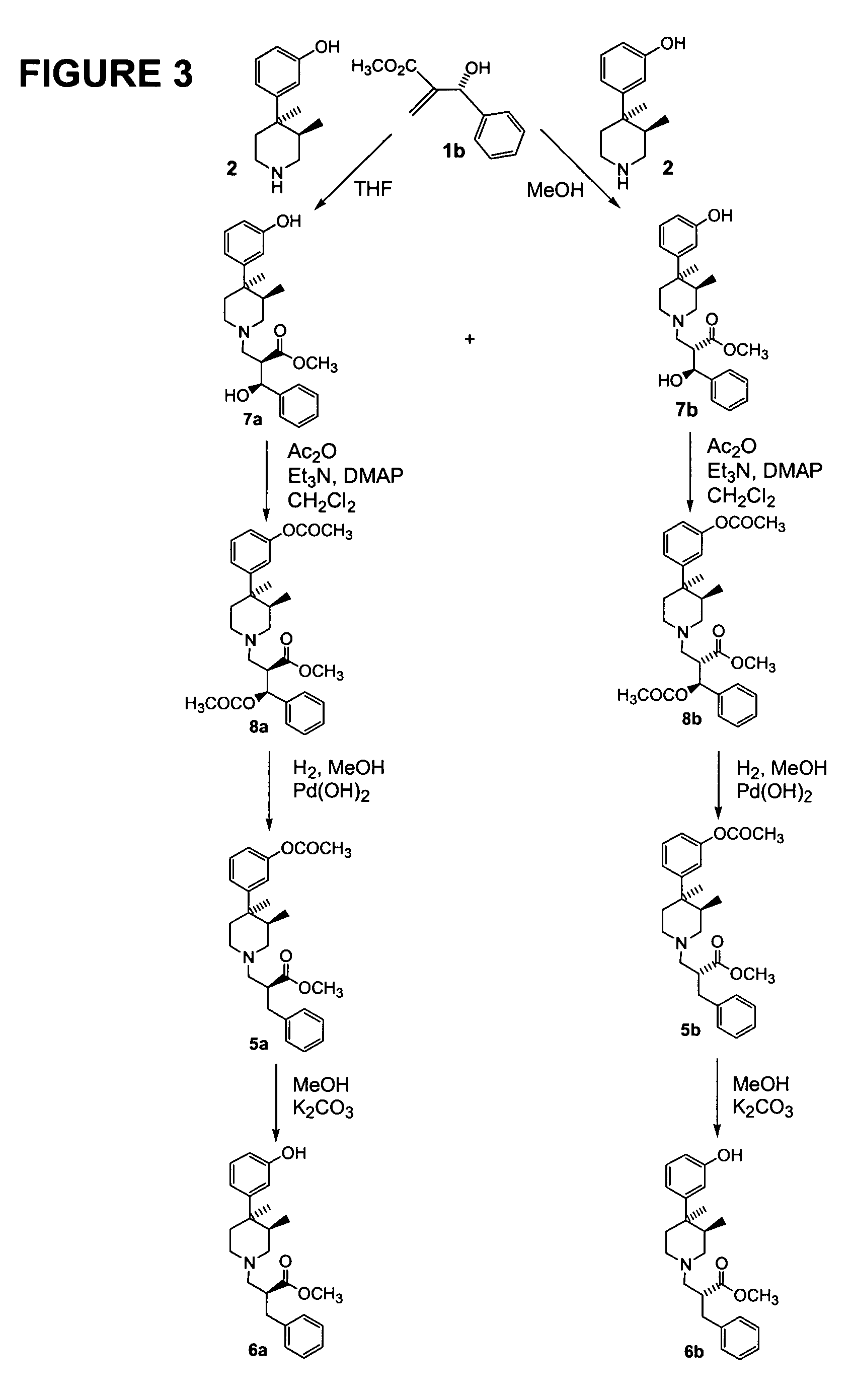Processes for the preparation of peripheral opioid antagonist compounds and intermediates thereto
a technology of opioid antagonists and intermediates, which is applied in the field of new drugs, can solve the problems of low intermediate yield (c) (34%) and low overall yield of alvimopan synthesis
- Summary
- Abstract
- Description
- Claims
- Application Information
AI Technical Summary
Problems solved by technology
Method used
Image
Examples
example 1
Preparation of precursor (±)methyl 3-hydroxy-2-methylene-3-phenylpropanoate (1).
[0614]Diazabicyclo[2.2.2]octane (5.2 g, 0.046 mol, 0.15 eq) was added to a mixture of benzaldehyde (31.5 mL, 0.309 mol, 1 eq) and methyl acrylate (42 mL, 0.464 mol, 1.5 eq). The reaction mixture was then allowed to stir at room temperature for 7 days. The reaction mixture was purified by column chromatography (eluent: hexane / ethyl acetate=95:5) to give the desired product as colorless oil (42 g, 77%). Rf 0.5 (hexane / ethyl acetate=7:3). 1H NMR δ (DMSO-d6) 3.6 (s, 3H), 5.43 (m, 1H), 5.73 (m, 1H), 5.98 (s, 1H), 6.19 (s, 1H), 7.29 (m, 5H).
[0615]Preparative chromatographic enantioresolution of the compounds of Example 1 was carried out by chiral separation using Chiralpak AS; 80% heptane (Fisher 012783), 20% isopropanol (Fisher 010923); 0.75 mL / min; room temperature; 20 μL inj.; UV 210 nM.
(+)Methyl 3(S)-hydroxy-2-methylene-3-phenylpropanoate (1a).
[0616]Rf 0.5 (hexane / ethyl acetate=7:3). 1H NMR δ (DMSO-d6) 3.6...
example 2
Preparation of methyl (αS,3R,4R)-4-(3-hydroxyphenyl)-3,4-dimethyl-α-(S-hydroxyphenylmethyl)-1-piperidinepropanoate (3a).
[0618]A solution of 1a (3.92 g; 0.020 mol; 1.05 eq), prepared according to Example 1, in methanol (10 mL) was added dropwise to a solution of(3R,4R)-3-(3,4-dimethyl-4-piperidinyl)phenol 2 (4 g; 0.019 mol, 1 eq) in methanol (50 mL). The mixture was stirred at room temperature under nitrogen for 60 h. The solvent was evaporated and the residual yellow oil was dried under high vacuum to yield crude product containing the 2 diastereoisomers 3a and 3b (see FIG. 2; ratio 3a / 3b=5.66:1; HPLC conditions: column Chiralcel OD 4.6×250mm; flow: 1 mL / min; mobile phase: 85% hexane / 15% isopropanol; λ=276 nM; Inj. Vol: 20 μL; 3a: tR=13.10 min, area: 85.5%; 3b: tR=22.88 min, area: 14.5%).
[0619]The 2 diastereoisomers were separated by column chromatography (eluent:hexane / EtOAc=9 / 1). Rf (3a) 0.27 (hexane / EtOAc=7:3); Rf (3b) 0.18 (hexane / EtOAc=7:3). The major isomer 3a was obtained as ...
example 3
Preparation of methyl (αR,3R,4R)-4-(3-hydroxyphenyl)-3,4-dimethyl-α-(S-hydroxyphenylmethyl)-1-piperidinepropanoate (3b).
[0620]A solution of 1a (1.05 g; 0.005 mol; 1.12 eq), prepared according to Example 1, in tetrahydrofuran (3 mL) was added drop wise to a solution of (3R,4R)-3-(3,4-dimethyl-4-piperidinyl)phenol 2 (1 g; 0.0048 mol, 1 eq) in tetrahydrofuran (20 mL). The mixture was stirred at room temperature under nitrogen for 72 h. The solvent was evaporated and the residual yellow oil was dried under high vacuum. The 2 diastereoisomers were separated by column chromatography (eluent: hexane / EtOAc=85 / 15). Rf (3a) 0.27 (hexane / EtOAc=7:3); Rf (3b) 0.18 (hexane / EtOAc=7:3). The major isomer 3b was obtained as white solid (0.360 g, 18%). 1H NMR δ (DMSO-d6) 0.57 (d, 3H), 1.10 (s, 3H), 1.40 (m, 1H), 1.75–1.90 (m, 2H), 2.00 (m, 2H), 2.25 (m, 1H), 2.45 (m, 2H), 2.80 (m, 1H), 2.95 (m, 1H), 3.55 (s, 3H), 4.61 (m, 1H), 5.57 (d, 1H), 6.50 (d, 1H), 6.63 (s, 1H), 6.66 (d, 1H), 7.05 (t, 1H), 7.28 ...
PUM
| Property | Measurement | Unit |
|---|---|---|
| temperature | aaaaa | aaaaa |
| temperature | aaaaa | aaaaa |
| time | aaaaa | aaaaa |
Abstract
Description
Claims
Application Information
 Login to View More
Login to View More - R&D
- Intellectual Property
- Life Sciences
- Materials
- Tech Scout
- Unparalleled Data Quality
- Higher Quality Content
- 60% Fewer Hallucinations
Browse by: Latest US Patents, China's latest patents, Technical Efficacy Thesaurus, Application Domain, Technology Topic, Popular Technical Reports.
© 2025 PatSnap. All rights reserved.Legal|Privacy policy|Modern Slavery Act Transparency Statement|Sitemap|About US| Contact US: help@patsnap.com



